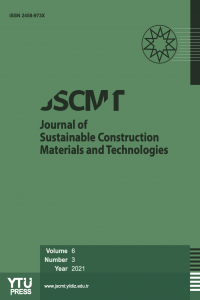Performance of Superabsorbent Polymer as Admixture in Hollow Concrete Blocks
Performance of Superabsorbent Polymer as Admixture in Hollow Concrete Blocks
Superabsorbent polymer, admixture, hollow concrete block, CCD, RSM,
___
- Dang, J., Zhao, J., and Du, Z. (2017) Effect of superabsorbent polymer on the properties of concrete. Polymers (Basel)., 9 (12), 1–17, https://doi.org/10.3390/polym9120672.
- Kim, Y.J., Hong, S.J., Shin, W.S., Kwon, Y.R., Lim, S.H., Kim, H.C., Kim, J.S., Kim, J.W., and Kim, D.H. (2020) Preparation of a biodegradable superabsorbent polymer and measurements of changes in absorption properties depending on the type of surface-crosslinker. Polym. Adv. Technol., 31 (2), 273–283, https://doi.org/10.1002/pat.4767.
- Wiegand, C., and Hipler, U.C. (2013) A superabsorbent polymer-containing wound dressing efficiently sequesters MMPs and inhibits collagenase activity in vitro. J. Mater. Sci. Mater. Med., 24 (10), 2473–2478, https://doi.org/10.1007/s10856-013-4990-6.
- Santhosh, Vasudevan, P., and Patwardhan, S. V. (1984) Trends in Polymer Applications in Agriculture. J. Sci. Ind. Res. (India)., 43 (3), 168–171.
- Behera, S., and Mahanwar, P.A. (2020) Superabsorbent polymers in agriculture and other applications: a review. Polym. Technol. Mater., 59 (4), 341–356, https://doi.org/10.1080/25740881.2019.1647239.
- Mechtcherine, V. (2016) Use of superabsorbent polymers (SAP) as a concrete additive. RILEM Tech. Lett., 1, 81, https://doi.org/10.21809/rilemtechlett.2016.18.
- Dolores, A.J.S., Lasco, J.D.D., Bertiz, T.M., and Lamar, K.M. (2020) Compressive strength and bulk density of concrete hollow blocks (CHB) infused with low-density polyethylene (LDPE) pellets. Civ. Eng. J., 6 (10), 1932–1943, https://doi.org/10.28991/cej-2020-03091593.
- Hasan, M., Saidi, T., Sarana, D., and Bunyamin (2021) The strength of hollow concrete block walls, reinforced hollow concrete block beams, and columns. J. King Saud Univ. - Eng. Sci., (xxxx), https://doi.org/10.1016/j.jksues.2021.01.008.
- Lefever, G., Snoeck, D., Aggelis, D.G., De Belie, N., Van Vlierberghe, S., and Van Hemelrijck, D. (2020) Evaluation of the self-healing ability of mortar mixtures containing superabsorbent polymers and nanosilica. Materials (Basel)., 13 (2), https://doi.org/10.3390/ma13020380.
- Schröfl, C., Mechtcherine, V., and Gorges, M. (2012) Relation between the molecular structure and the efficiency of superabsorbent polymers (SAP) as a concrete admixture to mitigate autogenous shrinkage. Cem. Concr. Res., 42 (6), 865–873, https://doi.org/10.1016/j.cemconres.2012.03.011.
- Lokeshwari, M., Pavan Bandakli, B.R., Tarun, S.R., Sachin, P., and Kumar, V. (2020) A review on self-curing concrete. Mater. Today Proc., 43, 2259–2264, https://doi.org/10.1016/j.matpr.2020.12.859.
- Cheng, B., Li, X., Liu, Y., Chen, M., and Du, S. (2022) Effect of Superabsorbent Polymers on the Self-Healing Properties of Pre-Damaged Concrete. Processes, 10 (11), https://doi.org/10.3390/pr10112333.
- Snoeck, D., Jensen, O.M., and De Belie, N. (2015) The influence of superabsorbent polymers on the autogenous shrinkage properties of cement pastes with supplementary cementitious materials. Cem. Concr. Res., 74, 59–67, https://doi.org/10.1016/j.cemconres.2015.03.020.
- Wisky, D., Bufalino, L., Alice, M., Savastano, H., Henrique, G., Tonoli, D., and Marin, L. (2021) Superabsorbent ability polymer to reduce the bulk density of extruded cement boards. J. Build. Eng., 43 (June), 103130, https://doi.org/10.1016/j.jobe.2021.103130.
- Morinaga, Y., Akao, Y., Fukuda, D., and Elakneswaran, Y. (2022) Delayed Absorption Superabsorbent Polymer for Strength Development in Concrete. Materials (Basel)., 15 (8), 2727, https://doi.org/10.3390/ma15082727.
- Yang, Z., Shi, P., Zhang, Y., and Li, Z. (2022) Effect of superabsorbent polymer introduction on properties of alkali-activated slag mortar. Constr. Build. Mater., 340, 127541, https://doi.org/10.1016/j.conbuildmat.2022.127541.
- De Meyst, L., Mannekens, E., Van Tittelboom, K., and De Belie, N. (2021) The influence of superabsorbent polymers (SAPs) on autogenous shrinkage in cement paste, mortar and concrete. Constr. Build. Mater., 286, 122948, https://doi.org/10.1016/j.conbuildmat.2021.122948.
- Mo, K.H., Ling, T., Alengaram, U.J., Yap, S.P., and Yuen, C.W. (2017) Overview of supplementary cementitious materials usage in lightweight aggregate concrete. Constr. Build. Mater., 139 (11), 403–418, https://doi.org/10.1016/j.conbuildmat.2017.02.081.
- Alfar, L., Ladera, J., Melitares, R., Cagas, R., Datoon, M.G., Tizo, M., Ido, A., and Arazo, R. (2023) Sugarcane Press Mud and Coconut Shell Ash: Promising Industrial Wastes as Admixtures for Concrete Block Pavement. Int. J. Pavement Res. Technol., 16 (3), 621–630, https://doi.org/10.1007/s42947-022-00152-3.
- DPWH (2016) DPWH Department Order No. 230, s. 2016 DPWH Standard Specification for ITEM 1046-Masonry Works.
- Pinoy Builders (2021) Hollow Concrete Blocks: All You Need to Know!
- ASTM C90 (2016) Standard Specification for Loadbearing Concrete Masonry Units. ASTM Int., https://doi.org/10.1520/C0090-16A.2.
- Carig, J.Z.S., Garcia, J.A.D., Lim, A. V, Nicolas, C.J.P., Saiyari, D.M., and Acosta, J. (2015) Utilization of Rice Husk Ash (RHA) as Partial Replacement to Ordinary Portland Cement (OPC) in Thermal Resistant Concrete Hollow Blocks (CHB). 2015 Int. Conf. Environ. Qual. Concern, Control Conserv.
- ASTM C129 (2017) Standard Specification for Nonloadbearing Concrete Masonry Units. ASTM Int., https://doi.org/10.1520/C0129-17.2.
- Frigione, M. (2013) Concrete with polymers, in Eco-Efficient Concrete, Elsevier, pp. 386–436.
- Snoeck, D., Jensen, O.M., and Belie, N. De (2015) Cement and Concrete Research The influence of superabsorbent polymers on the autogenous shrinkage properties of cement pastes with supplementary cementitious materials. Cem. Concr. Res., 74, 59–67, https://doi.org/10.1016/j.cemconres.2015.03.020.
- Başlangıç: 2016
- Yayıncı: Yıldız Teknik Üniversitesi
An architectural query of Anthropocene Era: Planned obsolescence
Mechanical behavior of large-diameter pipe elbows under low-cyclic loading
Oluwafemi AKANDE, Chioma EMECHEBE, Jonam LEMBİ, Joy NWOKORİE
Şevket Onur KALKAN, Lütfullah GÜNDÜZ
Assessment of a new rigid wall permeameter for the slurry like barrier materials: zeolite example
Hussaini MATO, Yahaya Hassan LABARAN, Dipanjan MUKHERJEE, Gaurav SAİNİ, Mahmoud Murtala FAROUQ
Performance of Superabsorbent Polymer as Admixture in Hollow Concrete Blocks
Phoebe Love CANDANO, Kate Rose ELORDE, Irl Rica Ann MEJOS, Rhoe James CABADA, Val Irvin MABAYO
